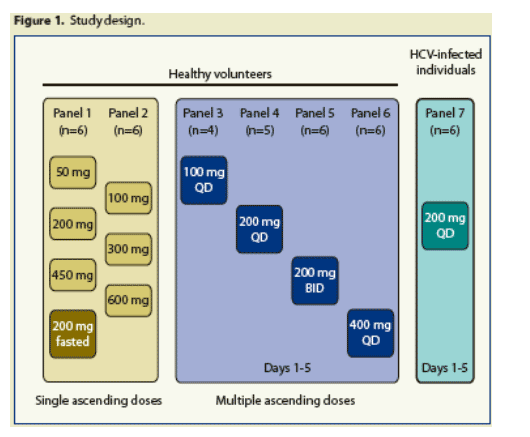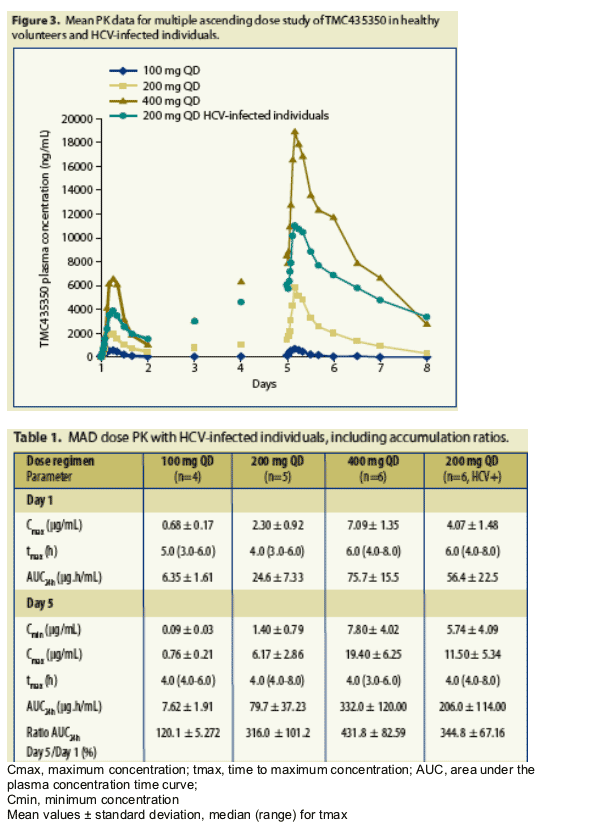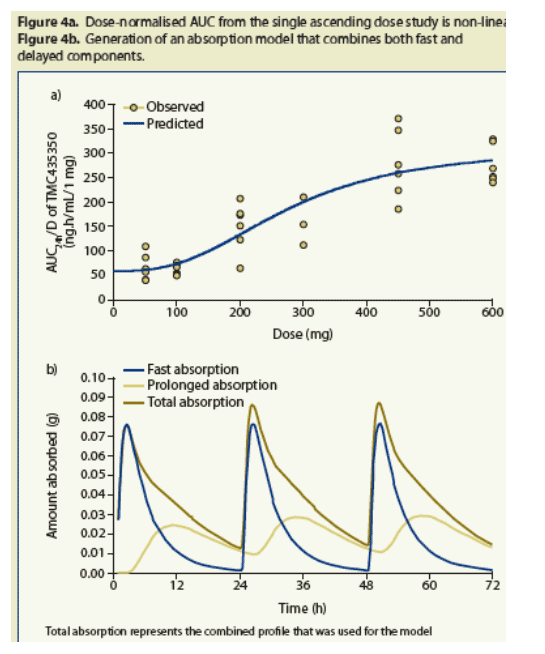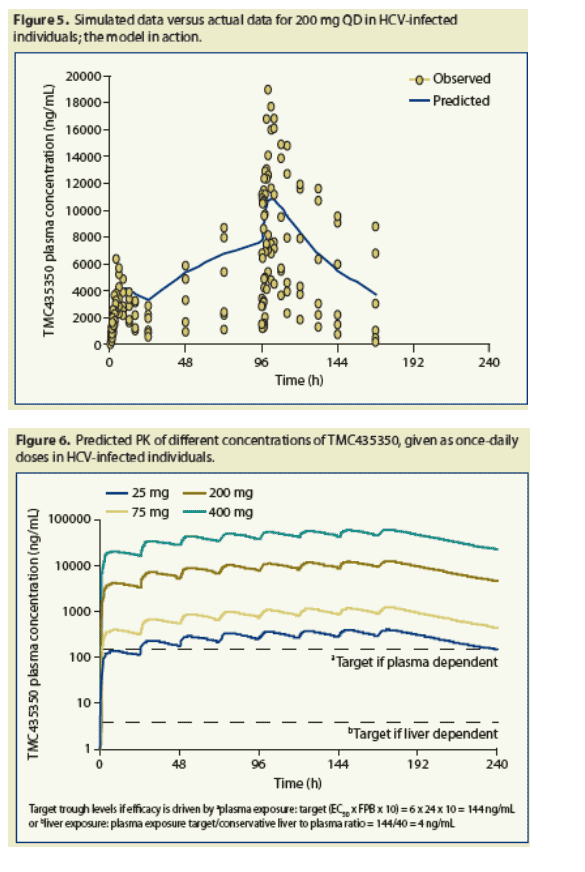 |
 |
 |
| |
ONCE-DAILY REGIMENS OF THE HCV NS3/4A-PROTEASE INHIBITOR TMC435350 ARE PREDICTED TO PROVIDE THERAPEUTIC EXPOSURE IN PLASMA AND LIVER
|
| |
| |
Reported by Jules Levin
43rd EASL Conference, April 23-27, 2008, Milan, Italy
Gerben A.E. van't Klooster,1 Iris Vanwelkenhuysen,2 Richard Hooijmaijers,3 Kees Bol,3 Marieke Voets,2 Jos Van Houdt,2 Rene A.L. Verloes,1 Fatima Aharchi,1 Kris Marien,1 Pieter Van Remoortere,1 Fabrice Broeckaert,1 Herman de Kock,1 Kenny A. Simmen1
1Tibotec BVBA, Mechelen, Belgium & Tibotec Pharmaceuticals Ltd, Cork, Ireland;
2Johnson & Johnson Pharmaceutical R&D, Beerse, Belgium; 3Kinesis Pharma, Breda, The Netherlands
AUTHOR CONLUSIONS
Data from trial C101 presented elsewhere demonstrate that TMC435350 was well tolerated in healthy volunteers at all dose levels studied (Verloes et al, 2007), and that 200 mg TMC435350 once-daily for 5 days reduced HCV RNA by 3.9 log10 in genotype 1 HCV-infected non-responders/relapsers (Reesink et al, 2008).
Single- and multiple-dose PK support the use of once-daily dosing of TMC435350.
The dose-disproportionality of TMC435350 PK can be accurately simulated using the model described.
PK modelling estimates indicate that efficacious doses may be as low as 25 mg QD in future Phase II clinical trials.
Introduction
TMC435350 is a potent inhibitor of the hepatitis C virus (HCV) NS3/4A serine protease.
TMC435350 was evaluated in enzymatic (HCV genotype 1 NS3 proteases) and cellular replicon models (Simmen et al, 2007):
-- EC50 = 8 nM for HCV genotype 1 in replicon assays (EC90 = 24 n
-- Human serum protein only increases EC50 by 2.4-fold (whereas the TMC435350 protein binding is 99.9%)
-- EC50 >10 _M against a panel of DNA and RNA viruses and human proteases tested in vitro-- Minimal cytotoxicity in tested human cell lines (SI _2000).
TMC435350 is extensively distributed to the liver and gastro-intestinal tract, with a liver to plasma ratio of >30 after a single oral dose of 40 mg/kg in Sprague Dawley rats (Simmen et al, 2007) and after 14 days of repeated oral dosing at 10 mg/kg/day in dogs (data on file).
In 6 HCV-infected non-responders/relapsers, 200 mg TMC435350 once-daily was associated with a median decrease in HCV RNA of 3.9 log10 (Reesink et al, 2008).
Here, the pharmacokinetics (PK) of TMC435350 in healthy- and HCV-infected volunteers are presented. PK modelling of TMC435350 was conducted to predict therapeutic dose regimens prior to entering Phase II clinical trials.
Methods
Study design
_ Study TMC435350-TiDP16-C101 (C101) was a randomised, double-blind, placebo-controlled trial to determine the safety, tolerability and PK of TMC435350 after single and multiple oral dosing.
Single ascending dose (SAD)
_ TMC435350 50-600 mg, as oral solution in PEG400; 2 panels of 9 healthy volunteers (Figure 1), 6 of whom received TMC435350 and 3 received placebo per session.
_ Fed conditions for all doses tested followed by an investigation of effects of fasting on PK profile and exposure of a single 200 mg dose of TMC435350.
_ Subsequent doses were separated by a washout period of minimally 10 days.
_ Full PK profile was studied with samples taken up to 72 h post-dose.
Multiple ascending dose (MAD)
_ TMC435350 100-400 mg, as oral solution in PEG400; 4 panels (panels 3-6) of 9 healthy volunteers (Figure 1) with a 2:1 randomisation to TMC435350 or placebo. In addition, panel 7 included patients with HCV genotype 1 (four 1a, two 1b) who were non-responders or relapsers to previous interferon-based therapy.
_ Full PK profiles were studied on Days 1 and 5, with pre-dose samples on Days 2, 3 and 4.

_ PK data from panel 5 (200 mg BID) will be reported elsewhere.
_ Safety and tolerability data from these studies have been described previously (Verloes et al, 2007; Reesink et al, 2008).
Bioanalysis
Plasma concentrations of TMC435350 were determined by LC-MS/MS
(lower limit of quantification = 2.00 ng/ml).
Statistical analysis
PK and statistical analyses were conducted using WinNonlin ProfessionalTM
(Pharsight Corporation, CA, USA) and/or SAS (SAS Institute Inc, NC, USA).
Results
SAD
_ Delayed time to maximum concentration (tmax) indicated slow or prolonged absorption of TMC435350.
_ Plasma exposure increase in TMC435350 was more than dose-proportional.
_ Dose-disproportionality was not associated with dose-dependent clearance (Figure 2).
_ There was no relevant effect of food on the PK of TMC435350.
MAD
_ Steady state was attained for TMC435350 100 mg QD dosing, with Cmin substantially in excess of HCV replicon EC50 (x 100).
_ Steady state was not achieved for TMC435350 doses _200 mg QD.
_ Mean exposures of TMC435350 in HCV-infected individuals were 3-fold higher than in healthy volunteers and were associated with a longer elimination half-life in HCV-infected individuals (41 ± 33 h vs 16 ± 5 h).


PK fitting and modelling to support predictions of exposure
in HCV-infected individuals
A simulation model of TMC435350 exposure, based on data from healthy volunteers, was developed to evaluate key determinants of the PK properties of TMC435350 and to predict the dose at which steady state could be attained.
Considerations for the model were:
-- dose-dependent bioavailability after single dose, with dose-dependent clearance (Figure 2)
-- degree of plasma accumulation is dose-dependent.
Exploratory assessments of PK modelling were conducted, assuming
-- both concentration-dependent and -independent drug clearance
-- a dose-dependent, sigmoidal model of bioavailability (Figure 4a)
-- a biphasic absorption with a fast and slow absorption component, with each component changeable as a function of dose (Figure 4b).
Based on clustering observed in the single accumulating dose study, dose groups were separated into low (50-100 mg), mid (200-300 mg) and high (450-600 mg), which allowed acceptable PK fits.
A convection dispersion equation was used to describe the delayed absorption profile (Freijer et al, 2007).
Simulations showed a high degree of accuracy when compared with
observed clinical data in HCV-infected individuals (Figure 5).
The model was used to calculate target trough levels of TMC435350 given as once-daily doses in HCV-infected individuals. Also considered were the high liver to plasma tissue distribution ratio in animals (assumed to be similar in humans) and the 80% bioavailability of a new capsule formulation relative to the oral solution (data on file).
At 25 mg QD, trough plasma and liver levels of TMC435350 are estimated at steady state to exceed the protein binding corrected replicon EC50 by
>15 and >500-fold respectively (Figure 6).


References
Freijer JI et al. Bull Math Biol 2007; 69: 181-95.
Reesink HW et al. Presented at the 43rd Annual Meeting of the European Association for the Study of the Liver (EASL), Milan, Italy, 23-27 April, 2008. (Oral presentation).
Simmen K et al. Poster presented at the 58th Annual Meeting of the American Association for the Study of Liver Diseases, Boston, MA, 2-6 November 2007. Abstract 1390.
Data on file, Tibotec Pharmaceuticals Ltd.
|
| |
|
 |
 |
|
|